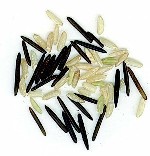 Rice researchers from Charles Sturt University (CSU) are urging caution with recent suggestions to increase agricultural production including rice in northern Australia, as it could invite unwanted rice diseases into Australia.
Rice researchers from Charles Sturt University (CSU) are urging caution with recent suggestions to increase agricultural production including rice in northern Australia, as it could invite unwanted rice diseases into Australia. “With climate change expected to create weather patterns across northern Australia that could encourage rice production, associated diseases of rice are also more likely to arrive and stay in Australia, especially if there is an extensive rice industry established in the tropical region,” said research team leader, Associate Professor Gavin Ash.
Working with the Cooperative Research Centre for Plant Biosecurity, Professor Ash, Dr Ben Stodart and Dr Ric Cother have carried out extensive surveys for diseases of native rice species in northern Australia, stretching across Queensland and the Northern Territory to the Kimberleys in Western Australia.
“We surveyed three native rice species in wetlands and floodplains in the tropical savannah in northern Australia, one of which is thought to be an ancestor of modern cultivated rice. We surveyed these plants to check if they were infected with any diseases currently unknown to the Australian rice industry, which is currently based in southern NSW and parts of Victoria,” Dr Stodart said.
“We did not detect any of the major known diseases of cultivated rice in our current survey, although our models predict that diseases such as rice blast could spread rapidly should it reach Australia from South East Asia. We did however find several bacterial and fungal diseases which have the potential to attack Australian cultivated rice varieties”
The researchers were particularly concerned at the suggestions to spread rice growing into northern Australia.
“Northern rice crops could act like a bridge,” Professor Ash said.
“As some of our native rice species are closely related to cultivated rice, some diseases could spread from these to cultivated crops.
“Our other concern is that rice diseases, that could be carried on the monsoon ‘jetstream’ from infected crops in Asia into northern Australia, would now have host plants if we renew rice cropping in the region. Once in Australia, they could then spread to the main rice cropping areas of southern Australia.”
The researchers are concerned about the continued need for monitoring of the northern regions and the persistence of quarantine borders around the rice growing regions in southern Australia.
“If we do expand agricultural production in northern Australia to take advantage of increasing water resources, we will also need to carry out surveys of alternate host plants for diseases that affect cultivated crops to provide information for strategic crop breeding and integrated disease management programs,” Dr Stodart said.





Social
Explore the world of social